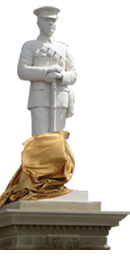Elizabeth (Bessie) Wilkinson Clayton
V.A.D. Voluntary Aid Detachment Nurse
 Photo: Elizabeth with her brother Alf Clayton.
Photo: Elizabeth with her brother Alf Clayton.
Elizabeth Clayton, known as ‘Bessie’ was born on 21st January 1893 in one of the houses at Ironville known as the ‘Big Six’. She was the daughter of Frances (Frank) and Hannah (Annie) Clayton. The family later moved to Dixie Street where Bessie grew up with brothers and sisters - Alf, Dorothy, and Frank. The Clayton family worshipped at Pye Hill Methodist Chapel and Bessie’s father and two brothers were all Methodist Circuit Preachers and Stewards. Additionally, her father Frank was Sunday School Superintendent at Pye Hill and her mother Hannah started the ‘Women’s Missionary Meetings’ there.
Elizabeth devoted herself to a lifetime of service. During World War One she served as a V.A.D. (Voluntary Aid Detachment) Nurse. Voluntary Aid Detachments first came into existence in 1909, their original purpose was to have trained voluntary workers who would assist nurses, should Britain be invaded. By the time war broke out in 1914, there were 40,018 women enrolled as members, reporting to 1,582 local detachments scattered all over the country. They served in many buildings, such as former schools, stately homes and town halls, placed at the disposal of the authorities to be used as auxiliary hospitals. Early in 1914, V.A.D.s were posted abroad, their first rest station being formed at Boulogne. In 1915, the Duke of Devonshire gave over Devonshire House, his London Residence to be used as the V.A.D. headquarters in Britain. The work of the V.A.D.s was so impressive that they were soon recruited to work in British hospitals, to assist the qualified nursing staff and release them for war work. Soon V.A.D. work was extended to include clerical duties, telephony, dentistry, and many other fields, which helped to fill gaps left by male workers serving in the forces. V.A.D.s were also trained as overseas field ambulance drivers and vehicle mechanics. In 1919, when the war had come to an end, it was decided that rather than waste the abilities of this devoted body of women, they should be offered scholarships at recognised training centres all over the country, to gain qualifications in medicine, dentistry, pharmacy, infant care and many other professions.
Elizabeth moved on to train as a teacher at Nottingham University, taking up her first teaching post at Codnor School. She also taught at schools in Mortlake, London; Carter Lane, Mansfield and the local village school at Bagthorpe.
Photo: Frances (Frank) Clayton (Bessie’s father), Hannah (Annie) Clayton (Bessie’s mother), sister Dorothy Clayton (seated) , Aunt Polly Platt and Bessie’s brothers Alf and Frank.
On 3rd August 1921, Bessie married William Burton at the Pye Hill Chapel. As a married woman she took a break from teaching but during World War Two, took up a teaching post at Bilsthorpe School, where her husband, William Henry Burton was the headmaster.
Connected with the Methodist Church since early childhood, Bessie became church organist at the Pye Hill Chapel, as well as Sunday School Teacher and leader of The Band of Hope. On moving to Bilsthorpe, she was a founder of the Bilsthorpe Methodist Church, church organist and ‘Young Wives Fellowship’ Organisor. As well as all this, Bessie also found time to be a Girl Guide Leader, a member of the Red Cross and bring up two sons of her own.
This remarkable lady died in 1977, aged 84.










